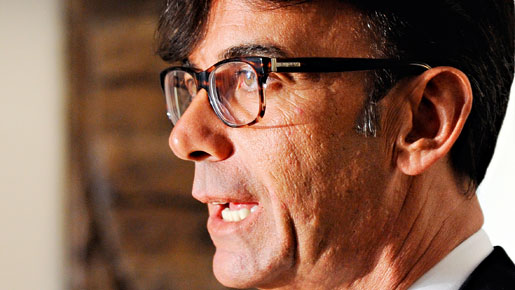
Patrizio Di Marco is an unusual man, at least if compared to fellow fashion executives. Since most luxury CEOs in the fashion biz prioritise commercial viability above all, it’s not unusual that conflicts arise between chief executives and their creative teams, who ardently fight their corner to maintain their vision. Gucci’s Creative Director Frida Giannini doesn’t belong to that unfortunate camp of designers. Di Marco’s approach is anything but regimented, and Giannini seems to have been given pretty much free rein.
“She’s made beautiful products from the beginning,” said Di Marco in 2009, which marked the beginning of his tenure. “She knows how to balance the fashion elements with Gucci’s heritage. Consumers want products with substance and good prices. We don’t need 75 variations of the same handbag. Two or three are enough. I don’t have to tell Frida to do anything other than to be herself.” It has to be said that Gucci lost its way somewhat before Di Marco stepped in, appearing rather mass market with too much focus on accessories priced, and designed, to sell in great numbers as opposed to nurturing Gucci’s brand values.
A return to roots
When initially joining Gucci two years ago, Di Marco’s prime agenda was to take the fashion house in a new direction, with focus on collections based around heritage and craftsmanship rather than logo-laden handbags and key rings. His strategy serves the company well, as does the fact that Di Marco and Giannini have established a relationship built on trust. The pair are often sighted at glittering outings ranging from the Venice Film Festival to various events at Milan Fashion Week, which serves as the platform on which the fashion house showcases its new collections every season.
The fact that Gucci is now back on track is a triumph indeed, particularly since the industry deemed Giannini’s chances of succeeding very slim. After all, she did enter Gucci in 2004 following the departure of the almighty Tom Ford. While Ford revamped the label in the mid-nineties with bells and whistles, and became the very face of Gucci in the process, today the brand goes about its business quietly, and since Di Marco was brought in to steer the label in the right direction, it has risen in rank both among consumers and industry folks.
Not to judge a book by its cover
Tall, dark and slender, Di Marco’s floppy fringe has become almost as much of a trademark as the sharp bob permanently sported by Vogue’s Anna Wintour. Di Marco, who is based in Florence where Gucci is headquartered, is a far cry from the macho type that traditionally dominates boardrooms, fashion-based or otherwise. The fact that he often wears glasses, which are sometimes so oversized that they seem to overpower his delicate features, only adds to his soft appeal. But despite his almost soppy demeanour, Di Marco is no push-over. Rather, he displays good intuition and has a sound grasp of the market.
His expertise has been cultivated over two decades. Before joining Gucci, he cut his teeth at a number of respected fashion houses. Prada and Louis Vuitton both form part of the Italian maestro’s impressive CV. One of the most important stepping stones that helped him reach the top was his tenure at BottegaVeneta, for which he served as CEO before joining Gucci. Di Marco’s efforts at the prestigious house – which, just like Gucci, forms part of the PPR (Pinault-Printemps-Redoute) stable – saw the company’s revenues grow tenfold.
Part of his strategy was to bring in a new creative director, Thomas Maier. The appointment of the designer – whose talent is signified by a refined sensibility but lacks the cool factor of his predecessor Giles Deacon – highlights the level of maturity and intuition Di Marco possesses. Still thriving on the foundations set by Di Marco, Bottega Veneta has carved a distinctive niche for itself, boasting an ever-growing clientele that will happily part with £5,000 to get their hands on Bottega Veneta’s most exclusive handbags. “I ran it like a start-up. I drew from my experiences — the innovation and passion that made Prada what it is today and some of the structure and financial discipline I learned at Louis Vuitton,” Di Marco said in an interview in 2010.
A rich heritage
When the recession hit, a trying period even for the strongest of brands, many fashion houses started to skimp on quality and innovation to be able to offer lower price points to cash-strapped consumers. Di Marco, in contrast, chose to take a different approach, and instead created interest and heightened brand value, capitalising on Gucci’s remarkable history. Part of the scheme involved the re-launching of archive pieces such as the Jackie bag (named after Jacqueline Kennedy) and utilising brand motives of the past, stretching as far back as to the 1940s.
Gucci has been in the limelight more than usual recently, as the brand turned 90 in 2011. To celebrate, a list of events have been rolled out throughout the year, one of which was the launch of the Gucci Museum (Gucci Museo) in the label’s hometown. Showcased within the imposing medieval palazzo is a wide range of pieces that tell the story of the fashion house, from its humble beginnings in 1921 – when founder Guccio Gucci launched a leather goods company and a small luggage store – to its modern incarnation as a mega luxury brand with few rivals.
“The museum is an homage to the city. Although Gucci is a truly international company, we are a Florentine success story,” said Di Marco in an interview. Showing that he’s determined to share Gucci’s success with the place in which the brand has its roots, Di Marco generously donated 50 percent of ticket sales to support restoring artistic monuments in the city. n

